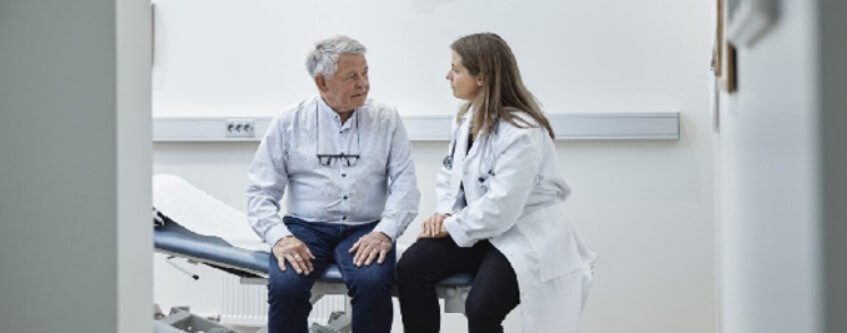
by Stemedix | May 27, 2024 | Health Awareness, Neurodegenerative Diseases, Parkinson's Disease, Stem Cell Research, Stem Cell Therapy
Getting any serious medical diagnosis can be frightening and intimidating. You might be unsure of what to do next or how to manage your condition. When it comes to Parkinson’s disease, the future can be even more uncertain since it’s a progressive neurodegenerative condition. It’s important to make a plan for how you’ll proceed after receiving a Parkinson’s diagnosis. You aren’t alone on your journey. Here are some steps you can take after your doctor tells you that you have Parkinson’s disease.
Understanding Your Diagnosis
Before you make an action plan, you should fully understand your Parkinson’s diagnosis. It’s important to know how this disease can affect your physical, mental, and social health in the future.
Parkinson’s Symptoms
Every person with Parkinson’s experiences the disease slightly differently. However, there are some common symptoms to watch out for as the disease progresses.
Common Parkinson’s symptoms include:
- Muscle tremors
- Insomnia
- Muscle stiffness
- Slow movements
- “Shuffle walk”
- Hunched or stooped posture
- Small handwriting
- Sudden soft or low speech
- Mood swings
- Sudden weight loss
- Decreased appetite
- Poor balance and coordination
- Dizziness and fainting
These are just a few of the warning signs and symptoms that Parkinson’s is progressing. Often, motor symptoms are the giveaway that someone has Parkinson’s over other diseases. It’s important to get an official diagnosis from a physician before seeking treatment.
What Causes Parkinson’s Disease?
The cause of Parkinson’s disease is the degeneration of neurons in the brain that produce dopamine. Dopamine is a neurotransmitter that helps control voluntary movements, and without enough of it, your movements become uncoordinated or involuntary.
Researchers don’t yet know the exact cause of Parkinson’s. The disease may have genetic components, but it seems to appear in combination with environmental triggers.
Certain risk factors make it more likely for someone to develop Parkinson’s. These factors include being male or over the age of 60. However, these risk factors aren’t guarantees that someone will develop this disease.
Is There a Cure?
There is currently no cure for Parkinson’s disease. Since it’s a neurodegenerative condition, the neurons that produce dopamine will continue to die off over time. However, modern innovative treatments like stem cell therapy may slow the progression of your symptoms to improve your quality of life.
You can also make lifestyle changes to mitigate some of the movement-related symptoms of Parkinson’s. Exercise and a healthy diet can keep you in good physical and mental shape, giving you a better ability to fight this disease.
Start Tracking Your Symptoms
After you’ve been diagnosed with Parkinson’s disease, you should start tracking your symptoms. Whether you use an app or a paper journal, it’s important to notice trends and patterns in your symptom development. These records will also help your doctor or Parkinson’s specialist come up with the best treatment plan for you.
You can break your symptoms down by category — movement, cognition, speech and swallowing, and other common groups of Parkinson’s symptoms. Then, record the date and severity of each symptom, noting any concerning developments along the way.
It may give you a greater sense of control and autonomy to keep track of what’s happening in your body as the disease progresses.
Piece Together a Treatment Team
Your doctor or Parkinson’s specialist may already have a treatment team for you, but if not, consider taking the steps to make your own. This may mean visiting different offices, seeking alternative therapies, and communicating with other Parkinson’s providers.
The more professionals you have on your side, the more robust and effective your treatments can be. Encourage your treatment team to communicate via medical charting or telephone so everyone can be on the same page. Always report any changes to your treatments to your primary care doctor or Parkinson’s specialist.
Get Plenty of Exercise and Gentle Movement
One of the best ways to slow the progression of Parkinson’s and retain your motor skills is to exercise. Whether you choose low-intensity activities, like walking or gentle stretches, know that you’re making healthy choices for your body.
The more your brain and body connect to produce voluntary movements, the stronger those connections become, which may help delay the onset of more severe movement symptoms. If you’ve never been physically active, now is the time to start.
There are low-impact exercises that don’t put stress and pressure on your joints. These include swimming, cycling, yoga and stretching, and elliptical workouts. Don’t feel like you have to push yourself to the max — any movement at all is healthy for you.
Improve Your Nutrition
The foods you eat play a large role in how you feel. If your diet is full of processed and refined foods, you may experience inflammation, fatigue, and other symptoms.
Eating a well-balanced diet with plenty of fruits and vegetables can keep you in good shape. Fruits and vegetables contain antioxidants, which are natural substances that fight aging and tissue damage.
If your goal is to slow the progression of Parkinson’s, incorporating more of these whole foods into your diet can’t hurt. See a registered dietician if you need help curating a healthy, well-rounded diet after a Parkinson’s diagnosis.
Evaluate and Try Different Treatments
Parkinson’s has no cure, but there are interventions and medical therapies that may help with your symptoms. From prescribed medications to holistic therapies to regenerative medicine, your options are plentiful.
Regenerative medicine, in particular, may offer surprising positive results for your Parkinson’s symptoms. Interventions like stem cell therapy for Parkinson’s may help reverse some of the cellular damage caused by this disease. These treatments get to the root cause of your symptoms and have the potential to improve your quality of life.
Physical therapy and speech therapy can be helpful for many Parkinson’s patients. These interventions help you regain motor control and improve your speech once the disease has started to interfere with these functions.
Staying Hopeful After a Parkinson’s Diagnosis
It’s important for you to have a strong support system, both medically and socially, to get through Parkinson’s disease. While it can be difficult, staying hopeful and cultivating gratitude can keep your mind in a positive place as you fight these symptoms. Never give up on yourself and your health, even if you’ve been diagnosed with a neurodegenerative condition.

by Stemedix | May 13, 2024 | ALS, Neurodegenerative Diseases, Regenerative Medicine, Stem Cell Research, Stem Cell Therapy
Amyotrophic lateral sclerosis (ALS) is a progressive neurodegenerative disease. Patients with this condition often experience a broad range of symptoms that get worse over time. While there’s no known cure, some interventions and regenerative therapies can be helpful.
If you or a loved one has been diagnosed with ALS, it’s important to seek as much information as possible. That way, you can get the proper treatment and know what to expect as the disease manifests in your body. Here’s everything you need to know to be prepared for ALS.
Lou Gehrig’s Disease: The Neurological and Muscular Effects
ALS is also known as Lou Gehrig’s disease. Unfortunately, it has severe effects on your nervous system and muscular function as it progresses.
Amyotrophic lateral sclerosis primarily affects your body’s motor neurons, which are responsible for dictating voluntary movements. Toward the end of the disease’s progression, involuntary movements like breathing can slow or stop entirely.
When your motor neurons can no longer communicate with your muscles properly, your muscles start to waste away. This is called muscular atrophy. Once a muscle has atrophied, it no longer has enough tone to carry out normal movements.
Since ALS is a progressive neurodegenerative disease, the symptoms get worse over time. In the later stages of the disease, ALS patients have trouble speaking, eating, swallowing, and making any voluntary movements at all.
Who Gets ALS? Risk Factors and Genetic Components
Amyotrophic lateral sclerosis is usually a sporadic disease, meaning patients get it randomly without an obvious known cause. In some cases, although very rare, Amyotrophic lateral sclerosis is passed down through families.
Genetic ALS stems from genetic mutations that are then passed on to children of affected parents. These cases only make up 10% or less of all ALS cases.
Sporadic ALS may have certain risk factors, but there are no clear causes. This means scientists can’t yet point to a single cause of developing ALS if it’s not genetic.
Possible Risk Factors for Sporadic Amyotrophic lateral sclerosis
Some loose associations between age, sex, and occupation have been made in relation to Amyotrophic lateral sclerosis cases. The presence of these risk factors does not guarantee that someone will develop ALS.
These possible risk factors include:
- Age: Being 55 to 75 years old
- Sex: Early-life cases are most common in men
- Military service: Veterans may be at higher risk
One possible reason that military veterans are at higher risk for Amyotrophic lateral sclerosis is because of their exposure to toxins like pesticides. Being around harmful chemicals may contribute to the development of this debilitating disease, but scientists aren’t sure of this.
The First Signs of ALS
There are two types of ALS onset — limb onset and bulbar onset. Limb-onset Amyotrophic lateral sclerosis affects your arms or legs or both at the same time. You may notice problems with coordination, fine motor control, walking, and using your hands.
Bulbar-onset ALS first affects the neurons that control your speech and swallowing abilities. You might notice difficulty getting your words out properly or trouble swallowing.
It doesn’t take long for the beginning symptoms of ALS to spread and get worse. This is often how physicians diagnose ALS, as rapidly progressing symptoms usually indicate a serious neurological problem.
Progressive Problems and More Serious Symptoms
As ALS develops, symptoms can become severe and even debilitating. Some patients experience changes seemingly overnight, while others develop more serious symptoms over weeks or months.
The neuron degeneration caused by ALS can start to interfere with essential body functions such as breathing, blinking, and swallowing.
Respiratory Symptoms
Respiration problems are common in end-stage ALS. The muscles in your chest that support breathing may become weak or paralyzed entirely.
Some respiratory symptoms of ALS include:
- Shortness of breath (at rest)
- Excess saliva
- Inability to clear your throat and lungs of mucus
- Pneumonia
- Weak coughing
- Worsened breathing when lying flat
- Respiratory system failure
Hospital interventions usually include ventilators to keep air flowing in and out of the patient’s lungs.
Muscle Stiffness and Atrophy
As Amyotrophic lateral sclerosis interferes with their proper use, your muscles start to lose tone, mobility, and structure. This is known as muscle atrophy and may be accompanied by extreme stiffness.
As Amyotrophic lateral sclerosis progresses, many patients lose the ability to speak loudly. The muscles involved in speech start to freeze up and become paralyzed. This can also cause an inability to swallow.
Extreme Weight Loss
Being unable to consume food and fluids normally can lead to excessive weight loss in late-stage Amyotrophic lateral sclerosis patients. This isn’t a healthy type of weight loss, and it’s usually caused, in part, by loss of muscle mass.
Mental Health Challenges
Amyotrophic lateral sclerosis doesn’t affect your perception or cognition, meaning you can still hear, see, and think normally. Since the person is aware of their deteriorating condition, they may experience depression, anxiety, and other serious mental health challenges. Having a strong support system is key to remaining mentally well through your ALS journey.
Treatment Options for ALS
You can receive treatment for ALS to slow the progression of the disease. While there is no cure, medical intervention can help you maintain your quality of life for a longer period.
ALS Medication
Some medications protect your motor neurons from further damage, which slows the progression of your ALS symptoms. These medications won’t revive damaged or dead neurons, but they can improve your disease prognosis.
Physical and Occupational Therapy
Therapies that involve movement and motor functioning can help you maintain your muscle tone and avoid stiffness. While you still have the ability to move your limbs and smaller muscles, it’s crucial to practice doing so as much as possible. This repetition helps your brain and body stay in a good rhythm and slow motor damage.
Regenerative Medicine
Some innovative treatments, like stem cell therapy for ALS, may improve your quality of life. Regenerative medicine focuses on healing and repairing damaged tissues and cells.
Stem cell therapy uses unspecialized human cells to serve specific purposes throughout the body. In the case of ALS, stem cells are administered so they can differentiate into nerve cells to assist with your functioning and comfort. This may be worth considering if you want to approach your ALS symptoms from all possible angles.
Living With Purpose: Life After an ALS Diagnosis
It’s important to maintain a positive outlook as much as possible. Having the support of medical professionals, family, and friends can make all the difference in your quality of life with Amyotrophic lateral sclerosis. Try not to lose hope; science is progressing toward new treatments every day.

by Stemedix | May 6, 2024 | Age Management, Health Awareness, Neurodegenerative Diseases, Parkinson's Disease
Parkinson’s disease affects your fine and gross motor skills. It might seem counterintuitive to try to exercise after your diagnosis, but physical activity is crucial. For seniors with Parkinson’s disease, exercise can boost mood, improve physical health, and improve motor skills.
Not sure where to start? Even just a few minutes of gentle exercise each day can help. Here’s what you need to know about exercising as a senior with Parkinson’s.
How Parkinson’s Disease Affects Your Nervous System
Parkinson’s affects sensory and motor skills in your body due to its effects on your nervous system. Your nerves are responsible for coordinating movements and sending signals to your muscles. When this system is flawed, motor problems arise.
Low Dopamine Levels
Patients with Parkinson’s disease have lower-than-normal levels of dopamine, a neurotransmitter in the brain. Dopamine is very important in voluntary movement. Parkinson’s is a neurodegenerative condition, which means it can progress over time as dopamine levels can steadily decline.
Problems With Executive Functioning and Cognition
Thinking, speech, and executive functioning are all impacted by Parkinson’s disease. Seniors with Parkinson’s may have difficulty feeling mentally clear, planning things, speaking, and remembering.
It makes sense that a neurodegenerative condition like Parkinson’s would impact a person’s cognition. After all, these changes originate in the brain. Luckily, exercise may have a protective effect for seniors with Parkinson’s-related cognitive problems.
Motor Problems
The symptoms of Parkinson’s disease include many different motor control problems. Often, tremors or problems balancing are among the first symptoms for seniors with Parkinson’s.
Movement and muscle-related symptoms include:
- Muscle stiffness
- Balance and coordination problems
- Changes in gait (walk)
- Tremors and involuntary shakes
- Handwriting changes
- Difficulty standing and walking
- Muscle contractions
These symptoms can interfere with your daily life, especially as your condition progresses. Exercise has therapeutic effects for seniors diagnosed with Parkinson’s disease. If you’re struggling with your symptoms, it’s worth a try.
How Exercise Benefits Seniors with Parkinson’s
Exercise is healthy for everyone, but it can be especially beneficial for Parkinson’s patients. Physical activity, including aerobic exercise and strength training, may have protective effects on the brain. This is key when it comes to preventing further progression of your Parkinson’s symptoms.
Balance and Coordination and Skills
Most types of exercise involve muscle coordination and balance. Even on a small scale, these exercises give your brain and body practice in strengthening your coordination and balance skills.
In seniors with Parkinson’s, balance and motor coordination are usually the first two abilities to weaken. Performing low-intensity strength training exercises, yoga, or dance exercises can strengthen these abilities and prevent further decline.
Muscle Tone and Strength
Seniors with Parkinson’s may develop low muscle tone and reduced strength. This happens when Parkinson’s limits your ability to control your muscles and engage in intentional movements.
Exercise can improve your muscle tone and strength through repetition and low-intensity training. Lifting light weights, like dumbbells or kettlebells, can train your muscles to move with intention and improve their function.
Cognitive Functioning
Physical activity of any kind boosts your neurological health. It helps your brain form new neural pathways and enforces new connections. This can be incredibly beneficial in slowing the progression of Parkinson’s disease.
Exercise may lead to better memory, cognition, and reasoning skills. It can also boost your speech and emotional regulation abilities as the disease progresses.
Working out will also keep your body in good shape, which is always helpful for slowing the aging process. Whether you have a disease or not, exercise can keep you youthful and healthy.
Quality of Life and Mobility
Your health is the most precious thing you have, and exercise improves your health over time. If you’re a senior with Parkinson’s, it’s important not to lose hope. Studies show that you can reverse some of the neurodegeneration that occurs as Parkinson’s progresses through high-intensity exercise.
Along with improving your quality of life, mood, and motor control, exercise helps you stay mobile and flexible. Doing activities like yoga, stretching, and tai chi will help preserve your mobility in the face of Parkinson’s disease.
Best Exercises for Managing Parkinson’s Symptoms
Now that you know the medical benefits of exercising regularly as a senior with Parkinson’s, where should you start?
It might feel intimidating to jump into a new exercise routine, but even mild activities can be helpful. Here are some of the most beneficial Parkinson’s management exercises.
Walking Outdoors
Getting out in nature boosts your mood, brain health, and physical abilities more than you might think. Just taking a 10- to 20-minute walk outside can help you better manage your symptoms.
Walking helps you refine your gait and avoid the “Parkinson’s shuffle” that many seniors fall victim to. By using your leg muscles and coordination to walk often, you’re making it easier for your body to carry this movement out properly over time.
Aerobic Exercises
Cardio does wonders for the brain and body. Aerobic exercise includes anything that gets your heart rate up, including jogging, swimming, and jumping rope. When it comes to Parkinson’s disease, aerobic exercise can boost your brain activity and health to help reduce cognitive decline.
Cardio also releases endorphins, which are feel-good hormones that boost your mood and improve your mental health!
If you’re new to cardio exercises, start slow. Walking is considered to be a form of cardio, and when you’re ready to increase the intensity of your workouts, you can do so steadily.
Flexibility Training: Yoga and More
It’s important to gently stretch your soft tissues to keep them elastic and prevent stiffness. As you live with Parkinson’s disease, flexibility is more important than ever. The more flexibility and mobility you maintain, the fewer complications you’ll have with movement in your daily life.
Consider signing up for an outdoor yoga class or group tai chi session to motivate you. These classes are usually designed to accommodate all fitness and ability levels, making them the perfect choice for seniors with Parkinson’s.
Parkinson’s and Exercise: Improve Your Quality of Life
You don’t have to sit back and let Parkinson’s disease take the reins of your life. Exercise has seemingly endless benefits for your physical, mental, and neurological health. Make exercise a priority so you can enjoy an improved quality of life as you navigate the world after a Parkinson’s diagnosis.

by Stemedix | Apr 15, 2024 | Multiple Sclerosis, Health Awareness, Neurodegenerative Diseases, Skin Care, Studies
Multiple sclerosis (MS) is a neurological disorder that can affect all of your body systems. People suffering from MS often report neurological, muscular, and skin problems as the disease progresses. If you have MS, you may develop puzzling skin symptoms and conditions that need to be addressed.
Your skin is the largest organ in your body, and it may need extra support if you have multiple sclerosis. Learn how MS symptoms and medications can affect your skin in your daily life.
Why MS Causes Skin Problems
Multiple sclerosis is a neurodegenerative condition that leads to increasing nerve damage over time. As a result, the ways your body experiences pain and physical sensations will change.
Nerve Degeneration
Some of this is purely neurological. As your nerves experience damage from this condition, they may misfire pain or sensitivity signals within your skin. You could have odd sensations, sensitivity to cold and light touch, and other skin problems.
Medication Side Effects
Additionally, Multiple sclerosis medications can lead to negative effects on your skin. Some of these prescriptions may irritate or inflame soft tissues in your body. As a result, you may experience infections, lesions, and rashes.
Common Neurological Skin Symptoms and Problems
When your nerves aren’t working properly, the way your body senses and responds to external stimuli (like touch) changes. These symptoms are what’s known as neurological skin problems. They don’t directly affect the appearance or texture of your skin, but these issues do impair your daily life.
Paresthesia
One of the earliest symptoms of Multiple sclerosis is paresthesia. This broad skin sensation can manifest in many different ways. Not everyone who experiences paresthesia has MS, but most MS patients deal with paresthesia at some point.
Some symptoms of paresthesia include:
- Numbness
- Tingling
- Prickling sensations
- Burning
- “Pins and needles”
- Tickling sensations
- Feeling like your skin is “crawling”
These symptoms show up even when nothing is physically touching your skin. Paresthesia is most common in your extremities — fingers, toes, hands, feet, legs, and arms. However, you may experience paresthesia in different spots on your body over time.
Neuropathic Itch
This skin problem is slightly different from paresthesia. When you develop neuropathic itch, it may feel like nothing will relieve the deep burning itch. Many MS patients struggle with this, and it doesn’t always involve external touches or stimuli.
Another name for neuropathic itch is pruritus. Even if there’s nothing physical causing the itch, it’s still a real sensation. It can be frustrating when the itch won’t resolve, even if you’ve scratched your skin excessively.
Skin Sensitivity: Cold, Touch, and More
MS patients experience extreme sensitivity to heat, cold, and touch due to nerve damage. This means even the lightest touch or slightest change in temperature can trigger a strong reaction in your body.
This makes everyday life difficult for obvious reasons. When you feel extreme pain and aversion to light touch or mild temperatures, it can be difficult to complete tasks and participate in society.
MS Medication and Skin Problems
Many MS patients have medications prescribed from their physician. However, the side effects aren’t always pleasant, particularly when it comes to your skin.
There are a wide variety of prescription drugs used to treat MS, so your specific symptoms will depend on what you’re taking. For example, monoclonal antibodies target certain immune cells to reduce the neurodegenerative and inflammatory effects of MS. However, this can irritate your skin and cause other unwanted side effects.
Here are some of the skin symptoms you may notice after taking MS medications.
Hives and Rashes
Patchy, itchy spots and raised hives can both stem from MS medications. This is because MS prescriptions deal with your immune system, inflammatory responses, and other bodily processes. These systems can and do interact with your skin, and sometimes, it responds by breaking out in hives or rashes.
Redness and Flushing
Some oral MS medications cause hot flashes, which make your skin look red and flushed. This is similar to the temporary skin sensations caused by exercise or anxiety. Most flushing sensations go away within 30 minutes of taking your medication, but they can still be a nuisance.
Skin Lesions
Some injections and infusions that treat MS can lead to skin lesions, which can affect your confidence and comfort. You may notice large or small skin lesions, with some being discolored or bruised.
Secondary Infections
When you have MS, your immune system constantly works overtime. This can weaken your defenses against secondary infections, like skin infections.
Scratching weakens your skin barrier, which can allow bacteria to enter your skin matrix and cause infections. If you’re dealing with neuropathic itch, you’re especially at risk.
Certain MS medications also make you more susceptible to skin infections. Injectable prescriptions carry the risk of exposing bacteria to different layers of your skin. Improper needle use and poor needle hygiene can both result in skin infections.
You’ll need antibiotic treatments for secondary skin infections, as these are bacterial and won’t go away on their own. Always consult your doctor for help with skin infections.
Care for Your Body to Reduce Your Skin’s Risk
Having MS is exhausting and can be debilitating. However, practicing physical and emotional self-care whenever possible can be beneficial. Caring for your overall health can reduce the impact MS has on your skin, making it less susceptible to infections and unpleasant symptoms.
Some forms of self-care for MS patients include:
- Getting plenty of rest
- Exercising regularly
- Journaling
- Meditating
- Eating a nutritious diet
- Doing yoga
- Spending time in MS support groups
- Talk therapy
These are all wonderful strategies for supporting your psychological and physical health when you have MS.
Be Prepared: Know the Most Common MS-Related Skin Symptoms
You can prepare yourself by learning about what you can expect after an MS diagnosis. MS has many detrimental effects on the body, but you can reduce some of these effects through stress relief and self-care. As you improve your overall well-being, you may notice skin improvements as well.

by Stemedix | Feb 26, 2024 | Parkinson's Disease, Health Awareness, Neurodegenerative Diseases, Regenerative Medicine, Stem Cell Research, Stem Cell Therapy
Parkinson’s disease causes nervous system complications. If you know someone who has struggled with this disease, you know how debilitating it can be. Parkinson’s affects mood, memory, cognition, and movement.
Fortunately, science is always advancing, and experts are learning more about Parkinson’s disease. Here are seven ways to help prevent Parkinson’s disease that are backed by scientific research.
1. Do Cardio Regularly
Cardiovascular exercise is linked to many other health benefits, but one of the most notable is reduced risk of Parkinson’s disease. Aerobic exercise, even in mild forms like walking or jogging, boosts your brain health. This improves and protects your memory, concentration, mood, and cognitive abilities as you age.
Cardio has an anti-inflammatory effect on your entire body. This is significant because researchers believe that Parkinson’s is the result of excess inflammation, among other factors. By getting a moderate to high amount of aerobic exercise each week, you can help protect yourself from developing this debilitating disease.
2. Relieve Stress in Healthy Ways
Psychological stress can be just as harmful as physical stress. Between the demands of work, family life, social circles, and hobbies, many modern Americans are more stressed than ever before.
It’s essential to reduce stress to stay healthy throughout your lifetime. Chronic high stress levels can contribute to whole-body inflammation, which is a serious risk factor for Parkinson’s disease.
Stress also reduces the volume of brain matter in areas that control memory, cognition, and movement, which are all negatively affected by Parkinson’s disease. By regularly combating stress, you can protect your brain and reduce your chances of developing this problematic condition.
Some healthy forms of stress relief include:
- Exercise
- Journaling
- Meditation
- Yoga
- Self-care days
- Getting at least eight hours of sleep at night
- Spending time outdoors
- Engaging in hobbies
These activities help you stay well-adjusted and free of stress, which weighs down your mental and physical health over time. Consider making changes in your life that cut out large sources of stress whenever possible.
3. Fill Your Plate with Veggies
Most people know that vegetables are extremely healthy. If you struggle to get your daily servings of veggies in, this information might make you reconsider your habits.
Vegetables naturally contain antioxidants, which are anti-inflammatory compounds that protect against aging and tissue damage. Filling your plate with vegetables increases your intake of antioxidants, vitamins, and minerals. All of these micronutrients contribute to better brain health and anti-aging.
When it comes to Parkinson’s prevention, this is one of the most effective steps you can take. If taste is an issue, consider adding more flavors to your meals to offset the taste of vegetables. You can also add seasoning and heart-healthy oils to make vegetables taste better.
4. Avoid Pesticides and Other Harsh Chemicals
Modern agriculture has changed a lot as humanity has progressed past the hunter-gatherer days. This means that crop growers are using more chemical pesticides than ever before. The long-term effects of these chemicals on human health are overwhelmingly negative.
Some studies have linked higher rates of Parkinson’s disease with high exposure to pesticides in farmers. The harsh chemicals used in large-scale agriculture are designed to keep bugs away from crops, but they can harm your brain health in the process.
To avoid this problem, shop organic and local whenever possible. Be mindful that many organic products can still contain certain pesticides. It’s best to shop at your local farmer’s markets and small grocery stores rather than chains.
These steps will help you access high-quality produce without exposing yourself to harsh, damaging chemicals.
5. Increase Your Vitamin D Intake
Vitamin D is incredibly important for immunity, mood, bone health, and brain health. Research has shown strong connections between Parkinson’s disease and low vitamin D levels. Now more than ever, getting enough vitamin D in your diet is essential.
You get some vitamin D from sunlight. The sun’s rays boost the amount of vitamin D in your bloodstream through chemical changes.
However, too much sun exposure is linked to skin cancer and other serious health problems. You should always wear sunscreen while spending extended amounts of time outdoors, and this can reduce the amount of vitamin D you get from the sun.
You should aim to get most of your vitamin D from your diet and supplements. Healthy sources of animal fat naturally contain lots of vitamin D. Opt for meats and dairy products that have “grass-fed” or “free-range” on the labels. These animals and their products are healthier and richer in vitamin D than factory-farmed animals.
If you struggle to get enough vitamin D in your diet, work with your doctor to find an appropriate supplement. Always consult a medical professional before starting a new medication or supplement.
6. Get Plenty of Sleep
Sleep is the most restorative and reparative process your body undergoes. Without enough sleep, your brain health is sure to suffer. Your memory, cognition, mood, and physical performance all rely on an adequate amount of sleep.
Parkinson’s disease is a neurodegenerative disorder, so it makes sense that chronic lack of sleep can raise your chances of developing it.
Healthy adults should get seven to nine hours of sleep every night. Your sleep needs may be slightly different from the recommended range. It’s important to pay attention to how you feel when you wake up.
If you wake up groggy, tired, and sluggish even after eight hours of sleep, chances are you need more. On the other hand, some people can thrive on seven to eight hours of sleep with no problems.
Sleep will protect your brain health and fight inflammation that can lead to Parkinson’s disease. Make getting plenty of shut-eye a strong priority in your life — your brain will thank you later.
7. Drink Coffee or Green Tea
Caffeine seems to have a protective effect against developing Parkinson’s disease. It’s important to get high-quality sources of caffeine. Otherwise, you may notice sleep disturbances and cardiovascular side effects. Avoid sugary, caffeinated beverages like energy drinks and soda.
Green tea and coffee both have antioxidants, which reduce inflammation and promote better brain health. You don’t have to give up your daily fix to fight Parkinson’s — in fact, it may help!
Know the Facts About Parkinson’s Disease
Stay updated on the latest information about Parkinson’s disease to reduce your risk of developing it. If you or a loved one are already struggling with Parkinson’s, therapeutic treatments like stem cell therapy may help. Ultimately, knowledge is power when it comes to fighting neurodegenerative diseases.

by Stemedix | Feb 13, 2023 | Neurodegenerative Diseases, Regenerative Medicine
While all injuries should be treated and properly resolved, there are certain injuries that can have more serious prognoses than others. Neurologic injuries are one of the more significant types of injuries someone can sustain. Injuries to the brain or spinal cord can result in various debilitating symptoms. Here we will learn more about Regenerative Medicine for Neurologic Injury.
In the past, a neurologic injury came with a dire prognosis. There were few treatment options, and many patients were left with symptoms like an inability to speak or paralysis.
Fortunately, advancements in medicine have led to an array of new treatment approaches to neurologic injuries. One way to address these types of injuries is through regenerative medicine. Learn more about how regenerative medicine can treat neurologic injuries below.
What is Regenerative Medicine?
Regenerative medicine, also known as stem cell therapy, involves stem cells that are the undifferentiated cells of a multicellular organism. These cells have the capability to produce and regenerate new cells of the same type. For this reason, stem cells can be potentially beneficial when managing numerous conditions.
Stem cells have the properties to help repair damaged cells or replace them with new, healthy ones. This has made stem cell therapy a potential approach when managing neurologic injuries.
Treating Neurologic Injury with Stem Cells
Recent studies have shown that mesenchymal stem cells can be used to manage injuries to the brain and spine. One of these studies was discussed at length at the 2022 American Academy of Neurology Annual Meeting.
A study by STEMTRA examined the efficacy of stem cells when treating patients with a TBI, or traumatic brain injury. Traumatic brain injuries occur when there is severe damage to brain tissue, resulting in the death of the tissue.
This scenario can lead to a number of symptoms, including the following:
- Loss of bowel or bladder control
- Loss of fine motor skills
- Difficulty speaking
- Impaired gait
- Paralysis
The study found that ongoing stem cell therapy helped a portion of these patients improve motor function and return to normal functional capabilities. Dexterity, gait speed, and even sensory reactions were improved with this stem cell treatment.
While studies are ongoing, stem cells are more often regarded as a potential treatment option for neurologic injuries. There is still research to be done to confirm how effective this type of regenerative medicine is for patients with grave injuries like TBI.
If you are interested in learning more about Regenerative Medicine for Neurologic Injury, you can inquire with a neurologist or regenerative medicine specialist at Stemedix for more information.







 St. Petersburg, Florida
St. Petersburg, Florida
